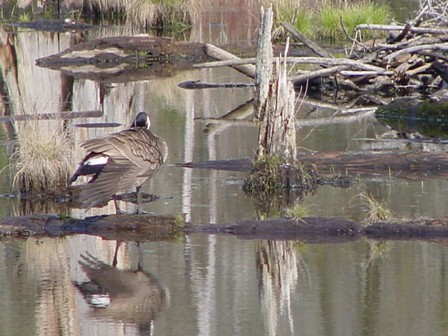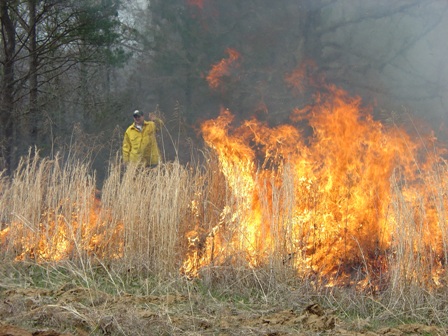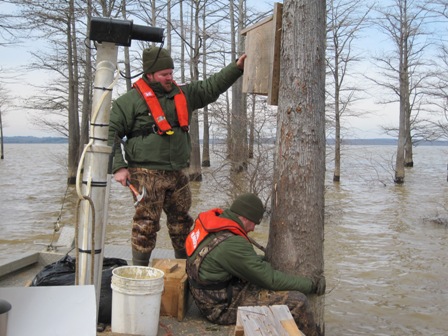 The natural environment surrounding Sardis Lake is a diverse ecosystem. As the rolling hills give way to vast hardwood river bottoms, the landscape captures a scene of beauty and serenity. Through natural resources management and environmental stewardship, the U.S. Army Corps of Engineers at Sardis Lake seeks to protect and preserve these resources to provide a healthy and sustainable natural world for our generation and future generations. The quality and health of our natural and cultural resource aspects, such as wildlife, fisheries, forests, grasslands, wetlands, air and water resources, are of the utmost importance to the U.S. Army Corps of Engineers at Sardis Lake. As stewards of the lands and waters at Sardis Lake, our ultimate goal is to effectively manage and protect natural and cultural resources through proven management tools and techniques in order to preserve them for the generations of tomorrow.
The natural environment surrounding Sardis Lake is a diverse ecosystem. As the rolling hills give way to vast hardwood river bottoms, the landscape captures a scene of beauty and serenity. Through natural resources management and environmental stewardship, the U.S. Army Corps of Engineers at Sardis Lake seeks to protect and preserve these resources to provide a healthy and sustainable natural world for our generation and future generations. The quality and health of our natural and cultural resource aspects, such as wildlife, fisheries, forests, grasslands, wetlands, air and water resources, are of the utmost importance to the U.S. Army Corps of Engineers at Sardis Lake. As stewards of the lands and waters at Sardis Lake, our ultimate goal is to effectively manage and protect natural and cultural resources through proven management tools and techniques in order to preserve them for the generations of tomorrow.
Forest resources at Sardis Lake comprise approximately 44,000 acres. They are managed to promote future resources of timber through sustained yield programs and reforestation and to provide recreational opportunities, wildlife habitat, erosion control, and aesthetics. These goals are accomplished through the application of accepted conservation practices, such as prescribed burning, fire lanes, cruising, planting seedlings, thinning, and improvement cutting.
The Use of Natural Resources Management Techniques
Natural resource management at Sardis Lake is promoted through a variety of management techniques and special events. Through the participation of volunteers and other Federal, state and local agencies, we practice and promote natural resource management techniques and environmental stewardship to ensure a safe balance between quality outdoor recreation experiences and the health of natural and cultural resources. The following is a listing of the natural resource management techniques used at Sardis Lake.
Management Techniques
 Prescribed Burning: Prescribed burns are used to remove undesirable vegetation from the forest floor of hardwood and pine timber stands. The controlled burns are used to reduce the amount of combustible materials available in the event of an uncontrolled wildfire. These controlled burns also remove litter from the forest floor allowing for new vegetation growth in the area. The new growth provides natural forage and browse for many game species, as well as, cover and feeding opportunities for ground-nesting game birds. Controlled burns are also used as a site preparation tool to clear an area of undesirable vegetation to be planted with more desirable tree species.
Prescribed Burning: Prescribed burns are used to remove undesirable vegetation from the forest floor of hardwood and pine timber stands. The controlled burns are used to reduce the amount of combustible materials available in the event of an uncontrolled wildfire. These controlled burns also remove litter from the forest floor allowing for new vegetation growth in the area. The new growth provides natural forage and browse for many game species, as well as, cover and feeding opportunities for ground-nesting game birds. Controlled burns are also used as a site preparation tool to clear an area of undesirable vegetation to be planted with more desirable tree species.
 Migrating Bird and Waterfowl Nesting Structures: The placement and preparation of nesting structures has been a common practice implemented at Sardis Lake. Bluebird, Wood Duck, and Purple Martin nesting structures can be found at Sardis Lake. The nesting structures are often placed at Sardis Lake with the assistance of local volunteers.
Migrating Bird and Waterfowl Nesting Structures: The placement and preparation of nesting structures has been a common practice implemented at Sardis Lake. Bluebird, Wood Duck, and Purple Martin nesting structures can be found at Sardis Lake. The nesting structures are often placed at Sardis Lake with the assistance of local volunteers.
Wildlife Food Plots: Wildlife food plots are planted and maintained yearly at Sardis Lake. These areas provide nutrition for White-tail deer, Bobwhite quail, Eastern wild turkey, migrating waterfowl species, rabbit, dove, raccoon and squirrel. Some of the planted crop species are sorghum, soybeans, chufa, millet, clover, wheat and corn.